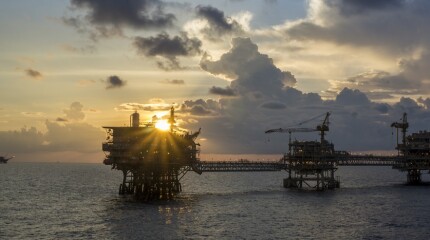Energy Transition Feed
-
The supermajor’s Energy Outlook 2025 suggests geopolitical fragmentation could tilt the balance of the energy trilemma toward energy security and away from sustainability.
-
The oilfield service company will supply power plants capable of electrifying 180,000 US homes with geothermal energy.
-
The fifth edition of the SPE Europe Energy GeoHackathon, beginning on 1 October, focuses on how data science can advance geothermal energy and drive the energy transition.
-
The update increases the guidance’s focus on creating a just energy transition.
-
This paper aims to describe the role of liquefied natural gas as a transitional energy source for automobile transportation in Nigeria.
-
This study concludes that it is relatively easy to generate enhanced hydrogen in the laboratory during injection of high-pH aqueous solution through a pack of olivine sand.
-
The SPE Reservoir Technical Discipline and Advisory Committee invite their Reservoir members worldwide to participate in a new survey aimed at assessing the current state of reservoir engineering across industry and academia. Deadline is 21 July 2025.
-
The SPE France Section marked a major milestone with its 40th anniversary celebration in March, held at the iconic Musée des Arts et Métiers in Paris. This historic venue—dedicated to centuries of engineering excellence—served as a fitting backdrop for an evening that honored legacy, acknowledged present challenges, and explored the evolving role of oil and gas profes…
-
DNV’s carbon capture and storage outlook forecasts a massive shortfall in the projects necessary to help the world reach net-zero emissions by 2050.
-
The Dutch marine contractor says it plans to outfit its construction vessels with small modular reactors over 5 years.
-
The emergency permitting rules aim to accelerate geothermal energy development. Ormat Technologies' three Nevada projects will be the first to benefit from the streamlined process, with environmental reviews cut from years to weeks.
-
The times are changing and so are our industry’s prospects, as hydrocarbons are now recognized as cardinal to affordable energy security for the conceivable future. But, in avoidance of suspense, the answer to the headline question is “absolutely.” Here we look at the rationale why.
-
EVP Giulia Chierchia and Chairman Helge Lund are stepping down amidst difficult Q1.
-
Young Professionals Leading the Energy Transition: Insights From SPE’s Beyond the Borders InitiativeIn March, 27 young professionals representing 15 SPE sections and 12 countries convened in Paris for the first edition of SPE Beyond the Borders 2025. The event served as a unique platform for cross-cultural dialogue and forward-looking discussions about the role of YPs in the energy transition.
-
The UK North Sea Transition Authority has awarded the required permits for the East Irish Sea project, and the project has reached financial close. The carbon capture and storage project is expected to receive its first carbon dioxide in 2028.
-
The test marks a milestone in the Poseidon CCS project, which aims to store carbon dioxide in the depleted gas reservoir below the Leman development in the southern North Sea.
-
The first phase of the Norwegian project is expected to receive its first carbon dioxide this year, with the second phase slated to start operations in late 2028.
-
Industry leaders say they believe oil and gas will continue to play a pivotal role in the energy mix in the lengthening energy transition timeline.
-
Experts speaking at CERAWeek 2025 lauded industry's shift from focusing on the energy transition to prioritizing oil production.
-
The supermajor is making a major course correction as it plans to slash renewable investment and focus more on oil and gas development.
-
This study highlights how the recovery and reuse of existing hydrocarbon infrastructure can contribute to the diffusion of district-heating projects that implement the principles of the circular economy.
-
This article kicks off a Q&A series from the SPE Research and Development Technical Section, focusing on emerging energy technologies. In this piece, Amy Bason of the Oil and Gas Climate Initiative highlights decarbonization efforts in global transportation.
-
The companies have announced they will work together to integrate geothermal well engineering and project delivery globally.
-
A recent report from Wood Mackenzie highlights the role of natural gas in supporting renewables and reducing emissions.
-
Closed-loop geothermal systems have entered the new-energy arena to generate electricity using the underground as a heat exchanger.
-
Equinor will reduce investments in renewables over the next 2 years by 50% to $5 billion and will increase its focus on oil and gas production, expecting more than 10% growth from 2024 to 2027.
-
Wood Mackenzie reports that prices would need to rise, capital discipline would need to evolve, and spending would need to increase by 30% for the upstream sector to meet demand in a delayed energy transition scenario.
-
The agreement aims to accelerate new commercial technologies that address challenges with geothermal development.
-
GEODE is a consortium led by Project InnerSpace and the Society of Petroleum Engineers and funded by the US Department of Energy’s Geothermal Technologies Office.
-
New IEA Report: Next-Generation Geothermal Can Go Global, But Oil and Gas Industry Must Show the WayThe upstream sector could help unlock geothermal energy’s potential but up to $1 trillion in project spending would be necessary over the next decade, the report says.






























